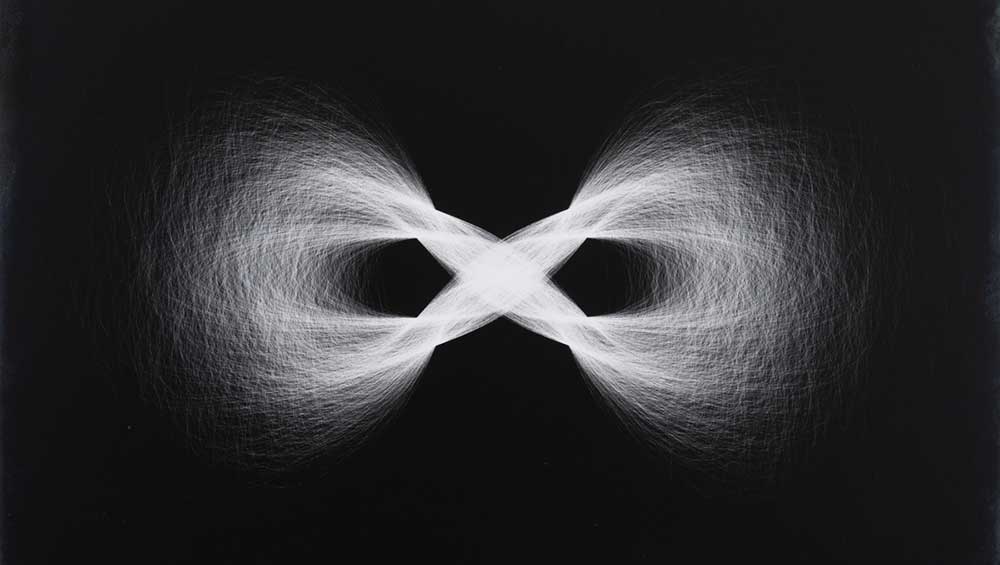
John Maeda. AI Infinity, 1993. Glossy C-type print mounted on board and ERC-721 token, 30 x 42 cm (11 3/4 x 16 1/2 in). Courtesy Gazelli Art House and certified by Verisart. Copyright of the artist.
Gazelli Art House, London
19 July – 21 September 2024
by BRONAĊ FERRAN
Building on a growth of interest in computer art from the 1950s to 1970s among curators, museums and collectors, which has coincided with a widening interest among younger practitioners in situating what they are doing now within a longer cultural lineage, this summer exhibition is timely and fascinating from a cultural and historical perspective. Focusing on an underexplored trajectory of works of art made with software as a primary medium from the 1990s to the present through the lens of seven artists, it takes us through a range of material, much of which has never been seen before in this country. It is also the third such group show filling in gaps in understanding of computer art histories to be organised at the agile Gazelli Art House over the last two years, following on from GEN/GEN: Generative Generations in 2023 and Code of Arms in 2022.

Robbie Barrat, Landscapes, 2022-2023. Plexiglass print of custom trained networks and other processing scripts, 16.4 x 25.1 cm. Courtesy of Gazelli Art House. Copyright of the artist.
Attending the exhibition’s preview, I am struck by its scale. With 51 works featured, it reminds me more of what might be staged at a museum show than at a commercial gallery, although lacking any interpretative panels. Its incantatory title, drawn from a poem written in 1993 by John Maeda, who has co-curated this exhibition, has stimulated diverse responses among the artists. From Robbie Barrat’s cyanotype-inspired e-printed flora to Lauren Lee McCarthy’s invitation to exchanges of human saliva, from John Maeda’s generation of Japanese modernist typographical icons to Golan Levin’s multicellular organic lifeforms to Joshua Davis’s hand-drawn lines over generative vectors, the exhibition blends human and technological, behavioural and algorithmic, organic and artificial codes. Such an approach gives the exhibition a striking contemporaneity combined with historicity that seems to me a smart intervention.
Acknowledging the relational and generational lines of connection underlying the narrative of the exhibition, its co-curator, Robert Norton has observed: “The decision to incorporate works from the 1990s from Maeda and Levin to the present day gives the viewer context in terms of what’s new and not so new when looking at the wider digital art market.” Norton is the founder of Verisart, a world-leading blockchain-based authentication system for art, who regularly works in close partnership with the Gazelli Arthouse.1 Maeda, who is now vice-president of design and AI at Microsoft, became famous in the 90s and 2000s in art and design circles as a digital visionary, practitioner and teacher, whose many influential books include The Laws of Simplicity.
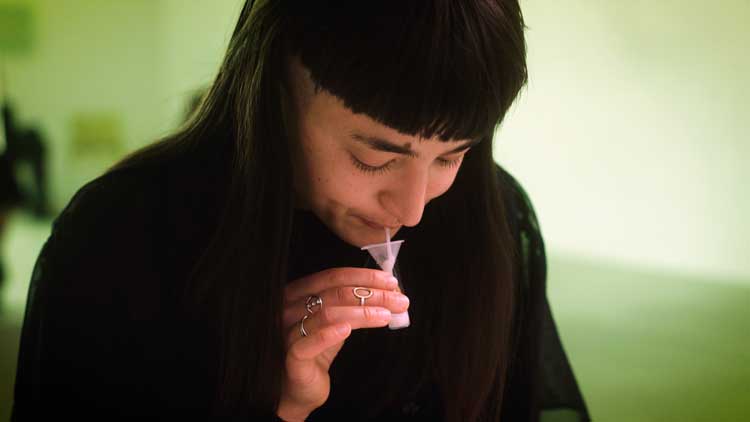
Lauren Lee McCarthy. Free Saliva Exchange, 2024. Installation including wall cabinet, testing equipment, vials and documentation, dimensions variable. Courtesy Gazelli Art House and certified by Verisart. Copyright of the artist.
The selected contributors link a period of generative art’s second wave of emergence, from the mid-90s to the mid-00s, with a third wave that rose as part of the web 3.0 phenomenon from 2018-22, which garnered relative mainstream attention and brought with it a new generation of collectors as well as the paradigm of buying art as non-fungible tokens (NFTs). This is a model that the exhibition adapts, sidestepping any assumption of a fundamental disconnect between digital and physical domains. With the exception of nine pieces by Barrat and one title by Levin and one by McCarthy, works on display can be bought in some version via the Verisart platform, with digital tokens acting as gateways to purchase of material that takes various formats, from high-quality prints on paper to MP4 files to digital plotter drawings, to interactive graphics.
One of these earliest works in the exhibition is by Maeda, entitled AI Infinity (1993). Developed initially as a generative code-based work using the PostScript programming language, with thousands of different iterations, in this exhibition one exemplary version is shown as a “glossy C-type print” on “aluminium dibond” and is being sold as a unique object.
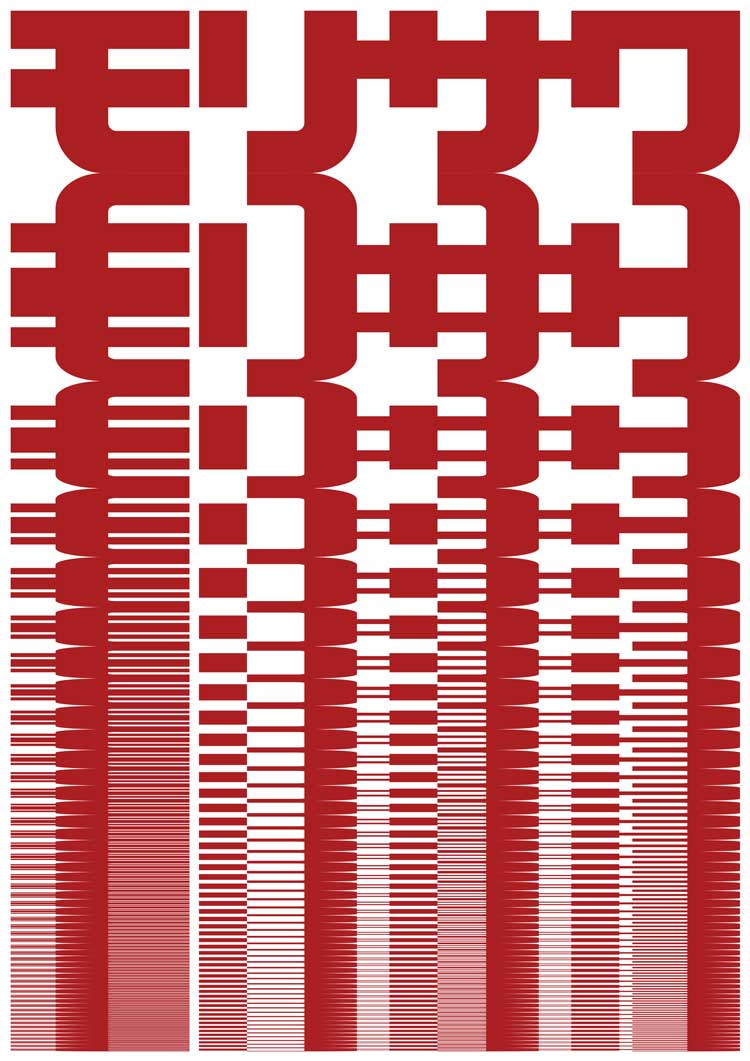
John Maeda. Morisawa 1, 1996/2024. C-Type print on photo paper and ERC-721 token, 103 x 73 cm (40 1/2 x 28 3/4 in). Courtesy Gazelli Art House and certified by Verisart. Copyright of the artist.
Maeda’s Morisawa 10 series (1996), dominates the opening space of the gallery. It also uses print as its medium of presentation. The large, square, prints on C-type paper hold the attention effortlessly, having a modernist typographical level of simplicity, while simultaneously conveying a point of radical transition from a logic of held type to a logic of generative data, evident in the balance of compositional and decompositional properties. Whether viewed hung on a wall or in online contexts, they transmit a sense of structural emergence, weighted in ways that hold time in space and place, and difficult to forget after viewing.
Maeda named the series Morisawa, after a Japanese type foundry associated with making a highly innovative leap in 1924 with the introduction of phototypeset Oriental language characters. Maeda has described how in the mid-90s he was “fascinated by emerging methods to work with letterforms on the computer” and said: “All [were] composed in the Adobe PostScript language (the predecessor to Scalable Vector Graphics) and were a little difficult to create because it was so expensive to make these images.” Seeing an exhibition of the Japanese artist Shikō Munakata’s folk-inspired works using large wooden letterforms was also influential.
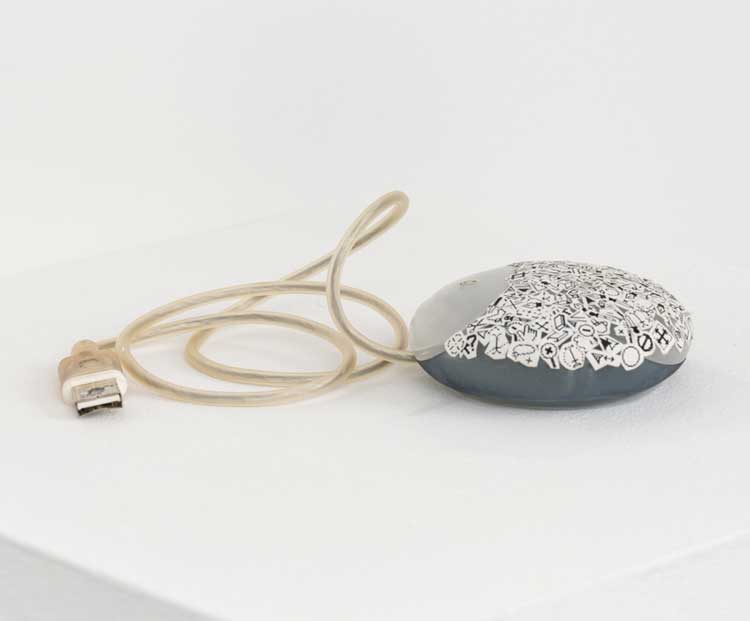
John Maeda. Metamagical Mouse 1996. Mouse, cable, laser print on paper and ERC-721 token, 10.2 x 10.2 cm (4 x 4 in). Courtesy Gazelli Art House and certified by Verisart. Copyright of the artist.
A zen-like effect, meanwhile, is transmitted by another work by Maeda, entitled Metamagical Mouse, also dated 1996. This is comprised only of a computer mouse interface and a cable resting on a plinth, and may easily be missed by the passing visitor. This conveys resonances of Maeda’s background in engineering, as a factor that finds form in various ways within this exhibition, where the youngest artist included, Barrat, who was born in 1999, foregrounds the functional, low-tech aesthetic affordances of the Raspberry Pi device in two of his wall-hung pieces. This strand of the exhibition, evident also in the inclusion of AI and generative adversarial network [GAN] painterly-style works made by “the engineering artist” Helena Sarin, pays tribute to Maeda’s own sense of relation to A Michael Noll, who brought art and engineering together in the early 1960s in developing pioneering examples of computer art in the U.S.
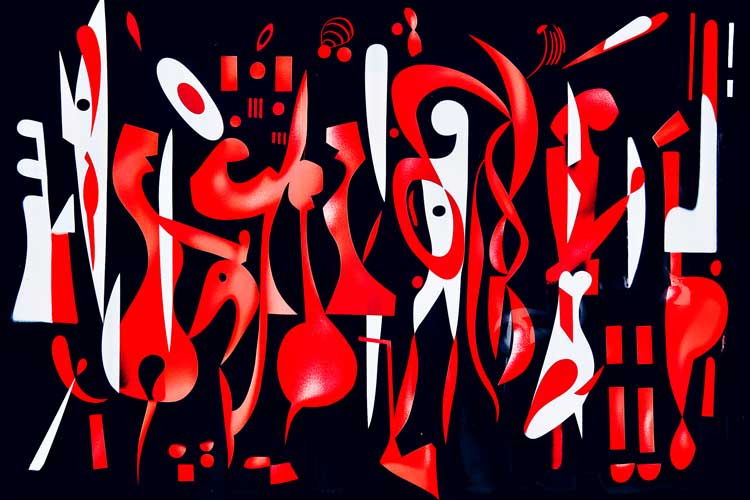
Helena Sarin. Dance me to the end of art, 2024. Still image ERC-721 token, 2048 x 2048 pixels. Courtesy Gazelli Art House and certified by Verisart. Copyright of the artist.
To be admitted to Maeda’s Aesthetics and Computation group at MIT in the 1990s, being able to code at an advanced level was a prerequisite. Two of his students, Ben Fry and Casey Reas, introduced Processing, the first (open-source) programming language created especially for artists, launched in the early 2000s. This has been used extensively by some of the other artists in this show and has been a critical factor in widening access to software as a tool and medium for creative expression.
Among the acknowledged “metamagicians” of art and computer code internationally are LIA and Joshua Davis. Both have used Processing in extensive ways, pushing the code to a new level of generative emergence while remaining closely associated with retaining a high degree of autonomy and control over their own processes and independent professional practices. While the number of works being shown by Davis and LIA in this exhibition is slight, their presence takes on a heightened symbolic significance in so far as they are showing their first ever collaborative work, entitled Coronation (2024), making a long-term friendship over 30 years more tangible.
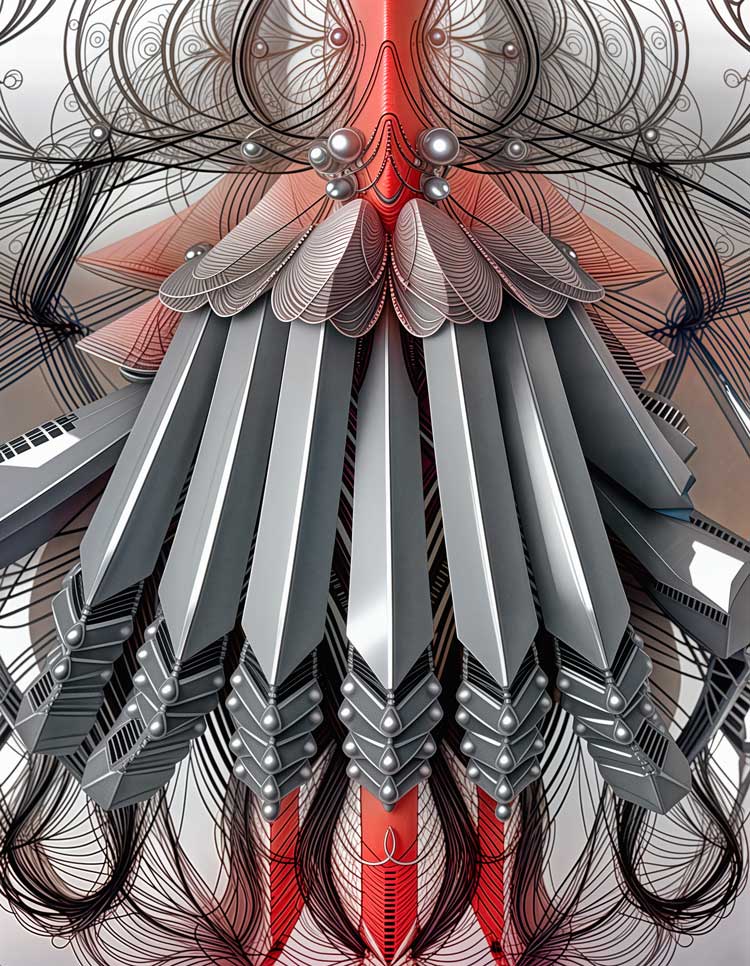
LIA and Joshua Davis, Coronation, 2024. Giclée print on Hahnemühle German etching paper and ERC-721 token of generative art as a still image, 59.4 x 84.1 cm (23 3/8 x 33 1/8 in). Courtesy Gazelli Art House and certified by Verisart. Copyright of the artist.
Their contribution to this exhibition has been spatially separated into one anteroom that somehow seems rather too small for the scale of their collective and individual contributions to a recent growth of interest among participants and collectors in what has become known as “the digital space”. The spatial arrangement makes what is shown, including two new works by LIA – There You Go, A Landscape! and Floral Greetings (2024) – alongside two new works by Davis seem here more decorative than they deserve. Yet for the large crowds who gathered in and near the narrow room during the exhibition’s preview evening, Davis’s subtly hand-drawn geometrical lines over a series of code-generated vectors in The V01D/Pulsar/ series stimulated a significant frisson of interest. As one of the world’s leading software artists, does Davis’s addition of a degree of handicraft represent a point of frictional resistance to the dominant frictionlessness of today’s AI?
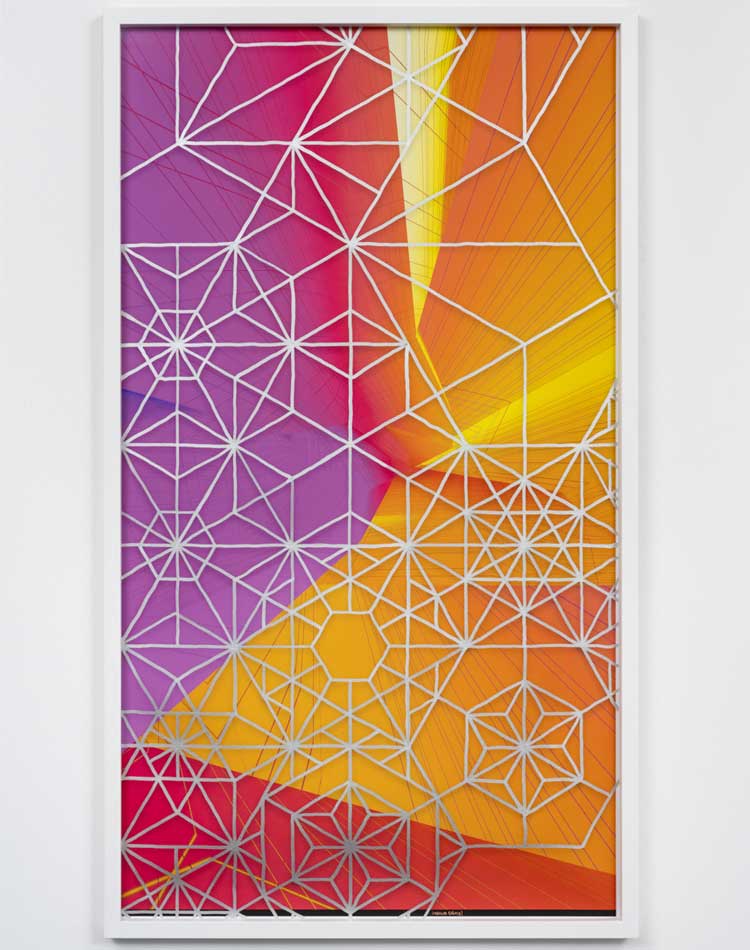
Joshua Davis. The V01D/PULSAR/ 000-001, 2024. Courtesy Gazelli Art House and certified by Verisart. Copyright of the artist.
My enjoyment of the range of works in this exhibition was also stimulated by seeing a set of works by the self-taught Barrat, that have many aspects of the low-tech, ecologically aware, programmatic/anti-programmatic aesthetic that seems to me to now be called for in any exploration of digital art within a broader trajectory of art and technological emergence. Barrat is a cult figure within web 3.0 discourse and practice, being prodigiously talented in coding and having become famous initially for his associations with the buzz of monetary speculation around NFTs between 2018-21. Now situating himself beyond that bubble, he is advancing what seems to me an important dimension of software-based art, that is incorporating neural nets and GANs into contemporary art making and doing this with a degree of critical reflexivity and, most importantly, a turn away from excess.
Barrat is now an art student in the Netherlands, having lectured at Stanford and interned at Nvidia, at exactly the same time as this company was working behind the scenes on some of the most critical aspects of neural network development that has underpinned the subsequent arrival of AI-based systems of machine learning into mainstream recognition. While what we see at the Gazelli may seem rather fledgling, it shows his capacity to combine within small frames and small screens the sense of “ostranenie” or alienation effect characteristic of AI visual effects and affordances, while situating this in correspondence with earlier phases of conceptual, landscape and programmed art as well as photographic history. Commenting on “Barrat’s nod to Sol LeWitt, in GPT-2 after Sol LeWitt (2019), and Lauren Lee Mccarthy’s Saliva Exchange (2022-ongoing)”, Norton has stated: “These works help us understand the artist’s own relationship to algorithms and also the way we as a society are being programmed.”
Indeed, genetic code is also included in the exhibition in the shape of McCarthy’s performative, interactive installation in one of the downstairs spaces. She encourages the sharing of saliva, as another kind of fluid emergence, that we usually ignore or take for granted. The work ventures into the ground of speculative bio-art design with McCarthy playing the role of scientific researcher, who gains the trust of her interviewees and records their responses to a questionnaire about the process of the saliva-gathering and its transformation into data that may be used in various nefarious or otherwise ways. As a documentary film, part tongue-in-cheek and part deadly serious, this work and the installation around it broadens the scope of the exhibition generally beyond software into the embodied and psychosocial codes that shape us daily. McCarthy, an associate professor at UCLA, is also the creator of p5.js, an open-source art and education platform with more than 1.5 million users.
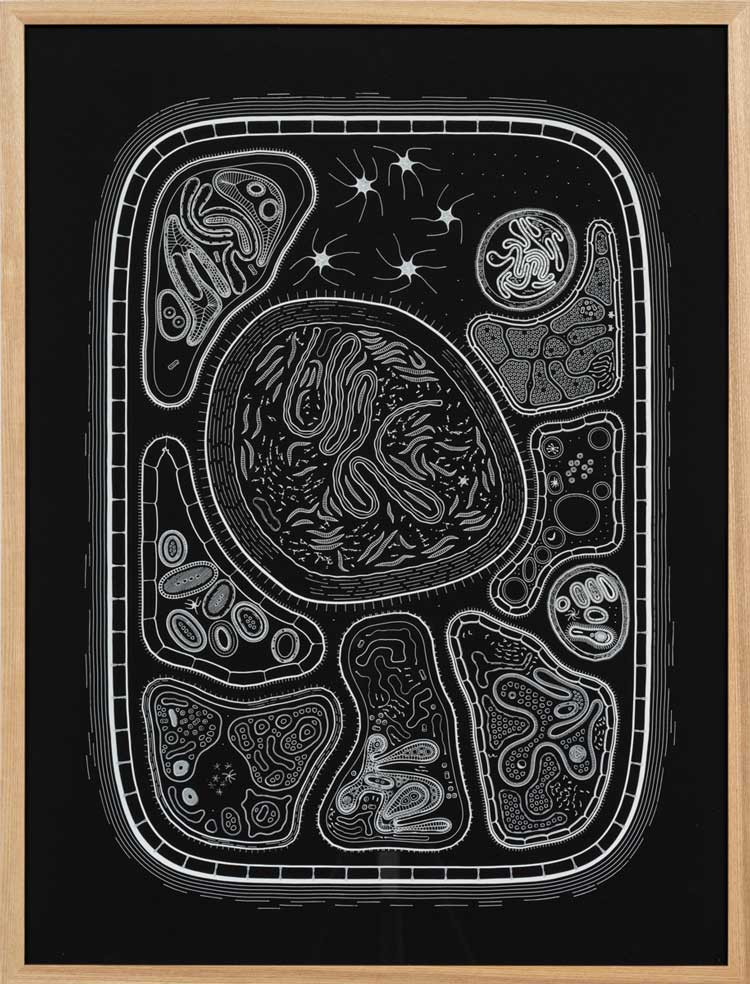
Golan Levin. Zoofolium, 08, 2024. Pen-plot in Sakura white gel ink on acid free 460gsm Fedrigoni Sirio Ultra Black cardstock and ERC-721 token, 61 x 45.7 cm (24 x 18 in). Courtesy Gazelli Art House and certified by Verisart. Copyright of the artist.
The exhibition includes 11 works by Levin, who also studied with Maeda in the mid- to late-90s and swiftly became well known internationally for a series of now seminal works within an interactive media lineage, winning awards at Ars Electronica and being part of leading festivals and exhibitions throughout the 2000s, often alongside LIA and Davis. We see here for the first time in London a mix of earlier and very recent works by Levin, that together provide extraordinary insights into software as a form of emergent life, that is often associated with forward-facing progression but has also inbuilt redundancy.
Levin’s approach to art with code has always seemed to me highly organic in its effects, hence his earlier association with notions of interaction, such as we see here revisited in three installations that are dependent on participation by others. One of these is Meshy, a real-time interactive graphic originally from 1998 and completely recoded for this instantiation due to the original software no longer being operational. We are invited to touch the screen with our fingers and to intuitively move an emergent grid of lines around as if we too are “metamagicians” who can communicate through touch with the underlying computer logic and bring something unexpected to life.
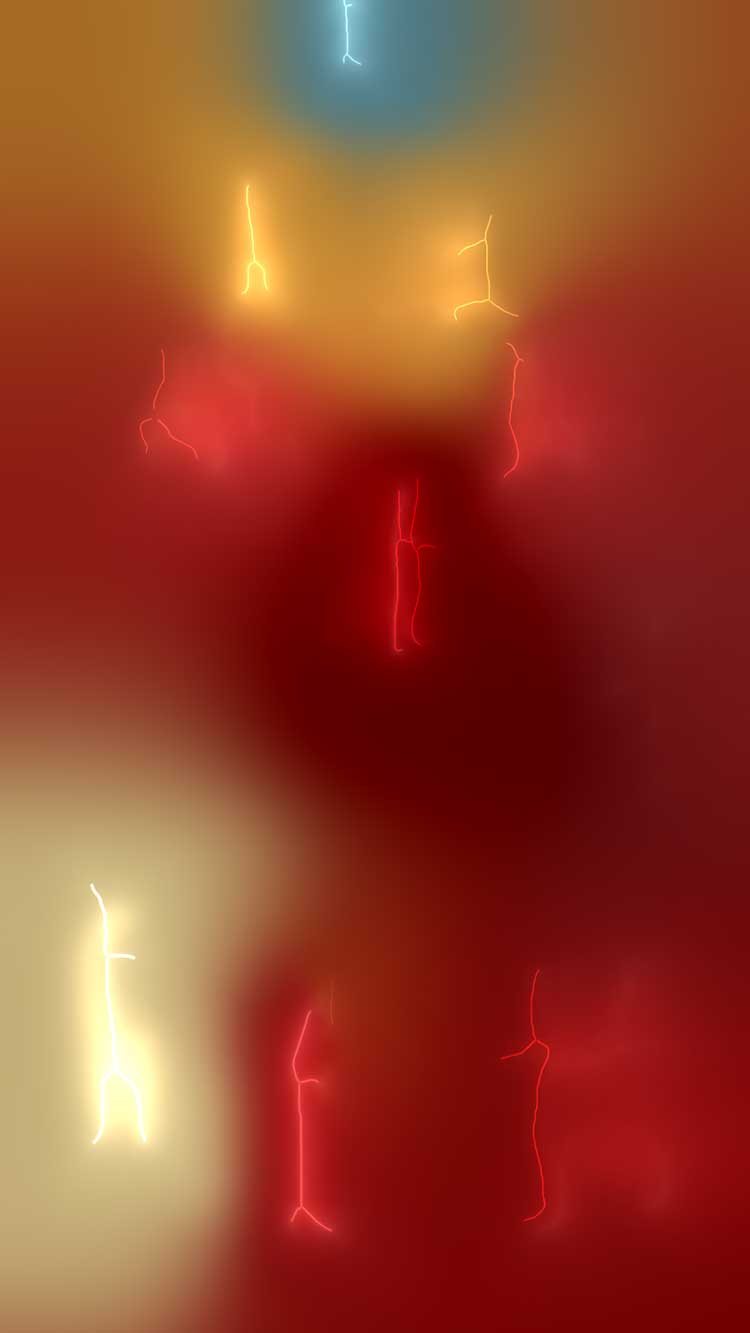
Golan Levin. Ghost Pole Propagator, III, (screen recording mov.), 2007–2024. Video installation, computer, security camera, dimensions variable. Courtesy Gazelli Art House and certified by Verisart. Copyright of the artist.
One of the multisensory pleasures of the exhibition is engaging with the third iteration of Levin’s Ghost Pole Propagator, which has been differently realised in each of its manifestations (previously in 2007 and 2016). Here, a hidden webcam observes the movement of people outside in the street, transforming their bodily rhythms into skeletal light-figures made visible to those inside. There is an interaction, moreover, between the colours we see on the screen and the points of movement, as if this technical process may also be tracking the hidden auras of people passing by, with the work poetically recalling for me aspects of the “Kirlian” light-based experiments in the mid-20th century, seen by some as tapping into “energy-matrixes in all living things”.2
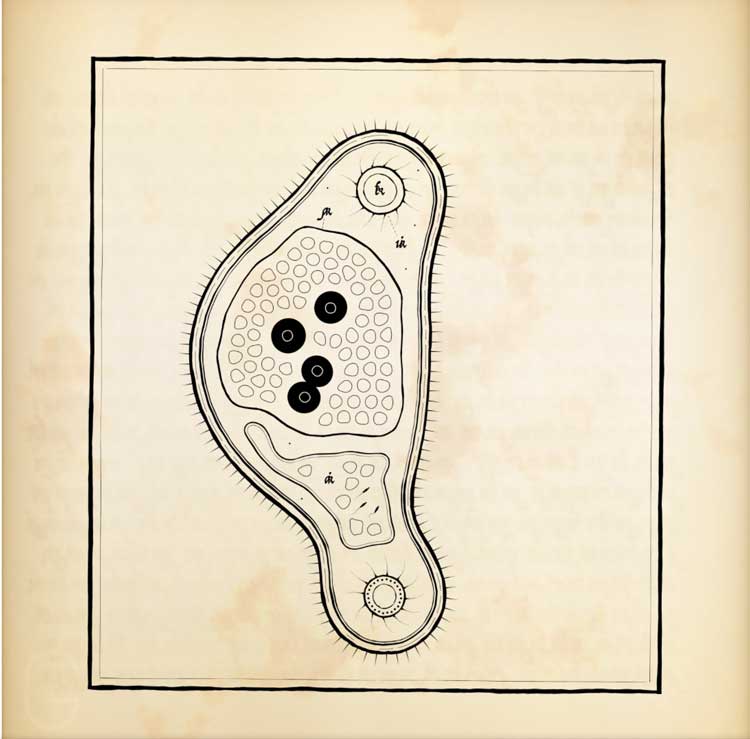
Golan Levin. Cytographia, #0 (still), 2024. HP7475 pen-plot in black 0.25mm Pilot Hi-Tec-C Gel ink on acid-free Canson Colorline 300gsm card and generative, real-time graphic, ERC-721 token
NFT with variable dimensions. Print: 20.3 x 26.7 cm (8 x 10 1/2 in). Courtesy Gazelli Art House and certified by Verisart. Copyright of the artist.
Indeed, one could spend hours tracing the marvellous fretting into works of contemporary code by Levin of various traces of prefiguring creative links and sources, some of these obscure or hidden in histories of technology and bought back to life within the multiplicities of his practice. In the recently launched work Cytographia (developed with p5.js software), for example, he refers in a text on the sources he has drawn on within it to his development of a series of generative letterforms “loosely based on 16th-century typefaces by Ludovico degli Arrighi”, and to “Robert Hooke’s Micrographia (1665), a landmark of scientific observation in which living cells were described for the first time” as well as “Edmund Fry’s Pantographia (1799), an attempt to compile exemplars of all the world’s writing systems”. One senses the backdrop of development in AI-research of large-scale language models during Levin’s creation of this work that he has also referred to as “an elegy for species we will never know, or will never know again, expressed through generative illustrations from an imaginary book about imaginary organisms … styled to evoke a hand-drawn engraving. Every aspect of this illustration is generated through custom code, including the simulated behaviour of the depicted creature, the poiesis of its anatomy, the calligraphic quality of its lines, the Ames letterforms of its labels, and the virtual ‘paper’ on which it is rendered.”
In contemplating this work on my computer and in the gallery, I find myself thinking back to a series of works on paper by Wassily Kandinsky in the 1930s, that were also characterised by “twitching or slowly pulsating micro-organisms – worms, amoeboids, embryos and marine invertebrates – viewed through a powerful microscope”.3 Like Kandinsky, so, too, Levin is interested in finding links and connections at a multicellular level between art and nature. Both were also drawing on biologist Ernst Haeckel’s late-19th-century writings, with Kandinsky using drawing and painting and Levin using code and computer plotter drawings. Might future generations of curators bring such material together and shift computer art out of its sometimes narrow niche? I left this exhibition assured that its artists seem to be pointing in that direction.
References
1. See here.
2. Supernature: A Natural History of the Supernatural by Lyall Watson, Hodder & Stoughton, London, 1973, pages 145-147.
3. Kandinsky: Watercolours and Other Works on Paper, by Frank Whitford, Royal Academy of Arts London, 1999, page 82